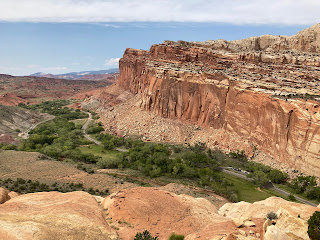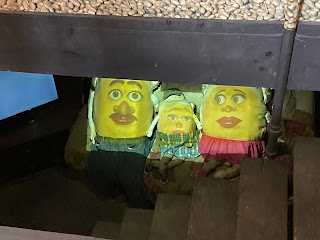It was our last vacation before baby #2 arrives in March. Neither Amber or I had ever really explored anything in Utah, so we decided to pick a couple National Parks to visit. Partly due to not wanting to face the insane crowds, and more of the things on my bucket list not being good items for a toddler, we decided not to visit Zion. We settled on Bryce Canyon and Capitol Reef National Parks for this visit, with a quick visit to a small portion of Grand Staircase-Escalante National Monument in between.
After getting off work late on Friday evening we booked it 2 hours south and stayed the night in a "Jail house turned apartment". We wanted to be 2 hours closer to the Salt Lake City area because I wanted to visit the Idaho Potato Museum in Blackfoot, ID. Being an Idahoan, it was my duty to visit and learn about all things potato.
Addie enjoyed a kids area where she was able to play with hundreds of Mr. Potato Heads. She also took a liking to the potato family that sings an annoying song about.... you guessed it.... Potatoes!
After finishing up we didn't do much else in the way of excitement except the long drive to Salt Lake City where we met up with my sister Emily at an Airbnb for the night. We prepped food and planned to get down to Bryce Canyon the next day.
The following morning we again didn't do much except drive the first half of the day. If you ever drive I-15 south through Utah you know there's not much to see. But when we finally turned onto Scenic HWY 12 it finally got interesting.
We headed straight for our campsite we had reserved for 2 nights, at the Sunset Campground. After eating lunch, visiting with Uncle Brett & Aunt Laurie (who were staying in the area a couple nights), and taking care of things at the park visitor center, we had a bit of time left to finally get our first views of the Bryce Amphitheater area and the "Hoodoos" at Sunrise Point.
Bryce Canyon sits at the upper North end of what is called the Grand Staircase. It's a massive uplifted plateau with sedimentary rock layers stretching from Southern Utah down to the Grand Canyon in Arizona. Most likely during the uplift of the continents and mountains during Noah's Flood, most of the sediment was removed from this region. It resulted in places like the Grand Canyon, Zion, and Bryce Canyon being exposed. In the short term, most scientists believe mechanical weathering has been responsible for forming the unique hoodoos that Bryce Canyon is famous for.
Bryce Canyon got it's name from a Mormon Pioneer couple named Ebenezer & Mary Bryce. The family was instrumental in making the Bryce Amphitheater and canyons more accessible. It became known as Bryce's Canyon, with the "s" eventually being dropped. In 1923 the area was designated a National Monument, and in 1928 it was changed to National Park.
After poking around Sunrise Point we headed back to our camp to relax, make dinner, and we planned to hike with Uncle Brett & Aunt Laurie in the morning. We would meet up with them and hike down among the hoodoos on the Queen's Garden Trail, and hike out on part of the Navajo Trail.
The next morning brought cold temperatures and we hadn't slept very well. But after breakfast we headed off to Sunrise Point to meet our relatives to do our hike. The descent down to Queen's Garden felt unreal, as this was our first time every being face to face with the hoodoos.
The Queen's Garden is an area of very impressive formations, one of them looking like Queen Victoria.
We took a break here, and then continued onto the Navajo Trail. We elected to not do the entire Navajo Loop, so we ended up doing the part that took us by Twin Bridges and Thor's Hammer. The views on this stretch of the trail were even more impressive, and the steep climb out back up to the rim was constantly gifting better views.
(Twin Bridges)
(Thor's Hammer)
After finishing up our hike we headed back to camp and had lunch. Then Amber and Addie hung out at camp while Emily and I decided to go on another hike. We headed out to the parking for Bryce Point and hiked about 1.5-2 miles down the Hat Shop Trail. The hikers were few and far between and we had the trail mostly to ourselves. While not as grand as the more famous trails elsewhere in the park, the solitude was a breathe of fresh air.
Then we began our hike up out of the "canyon" for the second time that day and we realized how tired we were. When we arrived back at camp we were content to rest for a couple hours before heading out again; this time to drive the scenic park road all the way to Rainbow Point.
Rainbow Point is the highest point in the park, reaching 9,115ft above sea level. It gives you stunning views to the North of the eroded formations that present a problem for people who believe the region was formed over the course of millions of years. On the top sits hard volcanic rock while the soft "pink cliff" clay layers show relatively little erosion in comparison.
While at Rainbow Point we hiked the Bristlecone Loop Trail and that gave us enough mileage in the park to get our "Hike the Hoodoos" award at the visitor center later.
After finishing up at Rainbow Point we drove back to camp, with the only spot we stopped at on the way back was Natural Bridge. We were too tired to do anything else besides head back to camp to make dinner, visit with our family, and bundle up for another cold night.
The next morning brought 30 degrees as we packed up camp, but we had stayed warm and had thankfully slept well. We headed out of the park on our way to Escalante, UT where we would have a chance to sleep in a warm cabin, get showers, do some laundry, and enjoy some more beautifully rugged scenery left behind from Noah's Flood.


























































